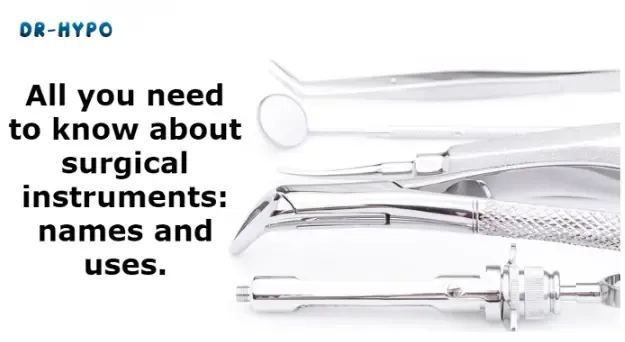كل ما تحتاج أن تعرفه عن الأدوات الجراحية بالإنجليزي
Surgical instruments with names and uses
Instruments are classified by their function
- Cutting & Dissecting
- Grasping & Holding
- Clamping & Occluding
- Exposing & Retracting
- Suturing & Stapling
- Viewing
- Suctioning
- Dilating & Probing
- Measuring
- Microinstruments
- Powered instruments
Cutting & Dissecting
- Cutting instruments have sharp edges.
They are used to dissect, incise, separate, or excise tissue.
- Most instrument sets will include #3 and #7 knife handles & suture, curved mayo, metz and tenotomy scissors.
Knife Handles
- Come in various widths & lengths
- Blades are attached by slipping the slit in the blade into the groove on the handle
Knife Blades
-
#10 are used for large skin incisions
-
#15 are used for short shallow incisions
-
#11 are used for initial skin puncture of tiny deep incisions
Other
Knife handles
-
Long handles are used inside deep incisions (e.g., open abdominal cases)
-
Beaver knifes are used for small delicate cases
Scissors
-
Blades of scissors may be straight, angled, or curved
-
Tips may be pointed or blunt, handles may be long or short
- Should be used only for their intended purpose
- Most instrument sets will include:
- Straight Mayo (Suture) Scissors
- Bandage/Dressing Scissors
- Curved Mayo Scissors
- Metzenbaum Scissors
- Tenotomy scissors
- Iris Scissors
Other cutting Instruments
- Ronguer
- Osteotome
- Curette
- Freer Elevator
- Rasp
Grasping & Holding
-
These instruments are used to grasp tissue and hold it in place without
injuring surrounding tissues
-
Forceps can be ringed or the thumbed variety
- Most instrument sets will include kocher, allis, Russians , Ferris Smith, babcock, adson, tissue, debakey forceps, sponge sticks & towel clips.
Clamping & Occluding
-
These instruments are used to apply pressure
-
Some clamps are designed to crush the structure when applied
-
Others are noncrushing and are used to occlude or secure tissue
- Most instrument sets will include mosquito, crile, kelly, tonsil, peon, and right angle clamps, Bowel Clamp, Vascular Clamp, Bulldogs.
Exposing and Retracting
- Used to pull Soft tissue and muscle aside to expose surgical site
- 2 types: Hand held & Self retaining
- Most instrument sets will include small hand held , army-navy, malleable, weitlaner, and richardson retractors.
Hand Held Retractors
Skin Hooks, Skin Hooks, Senn, Cushing Vein Retractor, Volkman, Army-Navy, Malleable, Richardson, Kelly, Harrington, Deaver.
Self Retaining Retractors
Weitlaner, Cerebellar, Gelpi, Balfour, Bookwalter.
Suturing and Stapling
-
Needle holder sizes vary according
to type of needle used
-
Most instrument sets will have
webster, crilewood, Castroviejo, Skin Stapler, Weck Hemoclip Applier, Ligaclip Applier, Staplers, and mayo
hegar type needle holders.
-
Clip appliers place individual staples, available in reusable and disposable
- Disposable staplers
Viewing
-
Surgeons can examine body
cavities, hallow organs, or
structures with viewing
instruments
- Procedures may be performed through them
- Most
instrument sets will include:
- Nasal Speculum
- Vaginal Speculums
- Rectal Speculums
- Rigid Endoscope
- Laparoscopic Trocars
- Laparoscopic Instruments
- Thorascopic Trocars
- Arthroscopy Cannulas
- Cystoscopy Sheath
- Camera & Light Cord
- Flexible Bronchoscope
- Flexible Ureteroscope
- Proctoscope
Suctions
- Yankauer
- Frazier
- Poole
Probes & Dilators
- Uterine Dilators
- Uterine Sound
- Urethral Sounds
- Lacrimal Duct Probe
- Vascular Tunnelers
Measuring
- Rulers
- Depth Gauge
- Total Hip Trials
Microinstruments
- Castroviejo Needle Holder
- Micro Scissors
- Bishop Harman Forceps
Powered Instruments
3 Types
- Battery powered
- Air powered
- Electric powered
Care & Handling of Instruments
-
Instruments are placed firmly into the surgeon’s palm in such a manner that it
is ready of immediate use.
-
Ringed instruments are handed with the box locks closed.
-
Curved instruments are passed with the curve in the direction of intended use.
-
To facilitate suturing the needle is secured about 1/8 inch down from the tip
of the needle holder and about a third of the distance from the eye or swaged
end
During
the procedure, used instruments should wiped with a damp sponge or placed in a
basin of sterile distilled water.
-
Do not saline on instruments.
-
Do not allow blood to dry on instruments.
- Saline & blood can damage instrument surfaces causing corrosion and pitting.
-
Flush suction tips with sterile distilled water periodically to keep lumens
patent.
-
Flush all lumened instruments thoroughly at the end of case to prevent blood
from drying inside lumens.
- Powered hand pieces and batteries should not be immersed in liquid as this could damage internal mechanisms.
You can view pictures of all the mentioned surgical instruments in this file: Surgical Instruments and Their Uses Illustrated.


إرسال تعليق